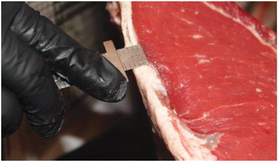Tips For Summer Grilling Season


Summer Grilling is here and it’s time to figure out what’s best for your meal. Ordering beef at the meat counter can be a daunting task if you’re new to the terminology. Understanding meat information can feel like learning a foreign language.
Sometimes information in a recipe also may not correspond with what is available at the meat counter, and price will also play a factor into which cut of meat you may choose.
The first step in choosing meat is to match the cooking method to the cut of meat. Some meat cuts are better for grilling, slow cooking, or braising. Most research in the meat industry is done on the rib muscle between the 12th and 13th rib, where information on meat quality is determined for U.S. Department of Agriculture beef grades.
Grilling and pan frying refers to hot searing heat that quickly cooks the outside and holds juices internally. Many higher end meat cuts use this method. If a cut of meat needs marinating, this method helps break down tougher cuts of meat using the spices and juices and gives flavor. Most marinades are time sensitive, so following the recipe is imperative. Roasting and braising are slower cooking methods. They usually involve large portions of meat that will cook at low temperatures and for longer amounts of time — “low and slow.”
Seasoning your meat can be a fun experience to try and invent your own spice mixture. Experimenting with different flavors can be rewarding. In addition to the four flavors: sweet, salty, bitter, and sour, beef has it’s own flavor profile and it includes Umami-savory, or the 5th flavor. Lamb and goat meat have their own flavor profile, while pork and chicken are much milder in flavor; hence, adding flavor to these is essential. They do not have as much fat in their meat, so adding spices helps enhance their taste. In recent years, there have been a few breeds of pork and poultry that have intramuscular fat or marbling, but a majority of breeds don’t. They would most likely need to be sourced locally from producers. All meat is inspected in the United States, but only some is graded. Graded meat helps consumers choose to buy a consistent product. A beef carcass is graded based on palatability using tenderness, juiciness, and flavor scores, as well as a yield calculation based on cutability, or amount of meat vs. fat. USDA meat grading evaluates the amount of marbling or intramuscular fat, maturity, color, and texture.
The USDA beef grades are classified as Prime, Choice, Select, and Standard for animals between 9-30 months of age. Prime carcasses have the highest value and fewer than five percent usually reach this classification. Most carcasses are Choice or Select and what is generally sold at a meat counter. Beef enthusiasts often look for a cherry-red color and consistent marbling of fat through the meat. Eating experiences can be greatly enhanced by understanding the language of American Beef and making informed cooking choices.
Ribeyes
Images of a ribeye shown cut in different positions along the 1st through the 13th rib section.
(Submitted photos)




